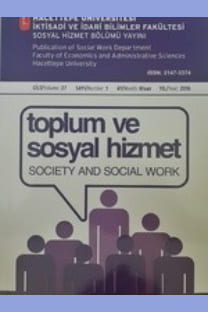KORONAVİRÜS (COVİD-19) SÜRECİNDE ÖĞRENCİ OLMA DENEYİMİ: BİR FOTOSES(PHOTOVOICE) ÇALIŞMASI
koronavirüs, sosyal hizmet, pandemi, uzaktan eğitim
The Experience of Being a Student During Coronavirus (Covid-19) Pandemic: A Photovoice Study
pandemic, social work, covid 19,
___
- Baum, F., MacDougall, C., & Smith, D. (2006). Participatory action research. Journal of epidemiology and community health, 60(10), 854.
- Cao, W., Fang, Z., Hou, G., Han, M., Xu, X., Dong, J., & Zheng, J. (2020). The psychological impact of the COVID-19 epidemic on college students in China. Psychiatry Research, 287, 112934. http://doi.org/10.1016/j.psychres.2020.112934
- Catalani, C., & Minkler, M. (2010). Photovoice: A review of the literature in health and public health. Health education & behavior, 37(3), 424-451.
- Clark, L., & Zimmer, L. (2001). What we learned from a photographic component in a study of Latino children's health. Field Methods, 13(4), 303-328.
- Çetin, C., &, Anuk, Ö. (2020). Covid-19 Pandemi Sürecinde Yalnızlık Ve Psikolojik Dayanıklılık: Bir Kamu Üniversitesi Öğrencileri Örneklemi. Avrasya Sosyal ve Ekonomi Araştırmaları Dergisi, 7(5), 170-189.
- Domenico, L. Di, Pullano, G., Coletti, P., Hens, N., & Colizza, V. (2020). Expected impact of school closure and telework to mitigate COVID-19 epidemic in France. Erişim tarihi: 16.04.2020 Erişim adresi: https://www.epicxlab.com/uploads/9/6/9/4/9694133/inserm_covid-19-school-closure-frenchregions_20200313.pdf
- Freire, P. (1972). Pedagogy of the oppressed Harmondsworth. UK: Penguin, 19721.
- Goodheart, Fern Walter, Joanne Hsu, Ji H. Baek, Adrienne L. Coleman, Francesca M. Maresca, and Marilyn B. Miller. 2006. “A View through a Different Lens: Photovoice as a Tool for Student Advocacy.” Journal of American College Health 55(1), 53–56.
- Hens, N., Ayele, G. M., Goeyvaerts, N., Aerts, M., Mossong, J., Edmunds, J. W., & Beutels, P. (2009). Estimating the impact of school closure on social mixing behaviour and the transmission of close contact infections in eight European countries. BMC Infectious Diseases, 9(187), 1-12. http://doi.org/10.1186/1471-2334-9-187.
- Karagün, E. L. İ. F. (2020). Spor Bilimlerinde Güncel Konular ve Araştırmalar-2 Covid-19 Pandemisiyle.
- Keskin, M., & Derya, Ö. Z. E. R. (2020). COVID-19 Sürecinde Öğrencilerin Web Tabanlı Uzaktan Eğitime Yönelik Geri Bildirimlerinin Değerlendirilmesi. İzmir Kâtip Çelebi Üniversitesi Sağlık Bilimleri Fakültesi Dergisi, 5(2), 59-67.
- Kürtüncü, M., & Kurt, A. (2020). Covid-19 pandemisi döneminde hemşirelik öğrencilerinin uzaktan eğitim konusunda yaşadıkları sorunlar. Avrasya Sosyal ve Ekonomi Araştırmaları Dergisi, 7(5), 66-77.
- Lögdberg, U., Nilsson, B., & Kostenius, C. (2020). Young Migrants’ Experiences and Conditions for Health: A Photovoice Study. SAGE Open, 10(2), 2158244020920665.
- Lune, H., & Berg, B. L. (2016). Qualitative research methods for the social sciences. Pearson Higher Ed.
- Nykiforuk, C. I., Vallianatos, H., & Nieuwendyk, L. M. (2011). Photovoice as a method for revealing community perceptions of the built and social environment. International Journal of Qualitative Methods, 10(2), 103-124.
- Russinova, Z., Mizock, L., & Bloch, P. (2018). Photovoice as a tool to understand the experience of stigma among individuals with serious mental illnesses. Stigma and Health, 3(3), 171.
- Sahu, P. (2020). Closure of universities due to coronavirus disease 2019 (COVID-19): Impact on education and mental health of students and academic staff. Cureus, 2019(4), 4–9. http://doi.org/10.7759/cureus.7541.
- Strack, R. W., Magill, C., & McDonagh, K. (2004). Engaging youth through photovoice. Health Promotion Practice, 5(1), 49-58.
- Tanhan, A., & Strack, R. W. (2020). Online photovoice to explore and advocate for Muslim biopsychosocial spiritual wellbeing and issues: Ecological systems theory and ally development. Current Psychology, 1-16. https://doi.org/10.1007/s12144-020-00692-6
- Viner, R. M., Russell, S. J., Croker, H., Packer, J., Ward, J., Stansfield, C., … Booy, R. (2020). School closure and management practices during coronavirus outbreaks including COVID-19: a rapid systematic review. The Lancet Child & Adolescent Health, 0(0), 1–8. http://doi.org/10.1016/S2352-4642(20)30095-X
- Wang, C. C., Cash, J. L., & Powers, L. S. (2000). Who knows the streets as well as the homeless? Promoting personal and community action through photovoice. Health promotion practice, 1(1), 81-89.
- Wang, C., & Burris, M. A. (1994). Empowerment through photo novella: Portraits of participation. Health education quarterly, 21(2), 171-186.
- Wang, C., & Burris, M. A. (1997). Photovoice: Concept, methodology, and use for participatory needs assessment. Health education & behavior, 24(3), 369-387.
- Wang, C., Cheng, Z., Yue, X.-G., & McAleer, M. (2020). Risk management of COVID-19 by universities in China. Journal of Risk and Financial Management, 13(2), 36. http://doi.org/10.3390/jrfm13020036
- ISSN: 2147-3374
- Yayın Aralığı: Yılda 4 Sayı
- Başlangıç: 2000
- Yayıncı: Hacettepe Üniversitesi İktisadi ve İdari Bilimler Fakültesi
KORONAVİRÜS (COVİD-19) SÜRECİNDE ÖĞRENCİ OLMA DENEYİMİ: BİR FOTOSES(PHOTOVOICE) ÇALIŞMASI
KAMU POLİTİKALARINA DAVRANIŞSAL YAKLAŞIM VE TÜRKİYE’YE YANSIMALARI
ÜNİVERSİTE ÖĞRENCİLERİNİN AİLE AİDİYETİNİN AİLEYE İLİŞKİN DEĞİŞKENLER AÇISINDAN İNCELENMESİ
Serap DAŞBAŞ, Nur Feyzal KESEN, Hüsnünur ASLANTÜRK
SOSYAL HİZMETİN ANLATI ARAŞTIRMASI İLE BULUŞMASI
KORUYUCU AİLELERİN KİŞİLİK ÖZELLİKLERİNİN İNCELENMESİ
Gülay YİĞİTOĞLU, Bilgin VURAL, Özlem KÖRÜKÇÜ
YENİ BİR YAKLAŞIM OLARAK DİLBİLİMSEL SOSYAL HİZMET
KÜLTÜRE DUYARLI SOSYAL HİZMET UYGULAMALARINDA SAĞIR TOPLUMUNU DÜŞÜNMEK
ÇOCUĞA YÖNELİK CİNSEL İSTİSMARIN AÇIĞA VURULMA SÜRECİ HAKKINDA BİR DERLEME
ODAKLAN, KEŞFET VE FARK ET: YAŞLILAR İLE ÇALIŞMADA BİLİNÇLİ FARKINDALIK TERAPİSİ
SURİYELİLER VE SOSYAL UYUM: SCUDDER’İN ÇERÇEVESİNDEN BİR DEĞERLENDİRME
